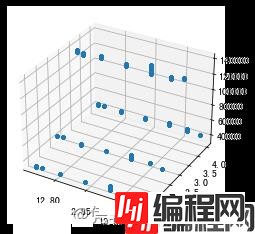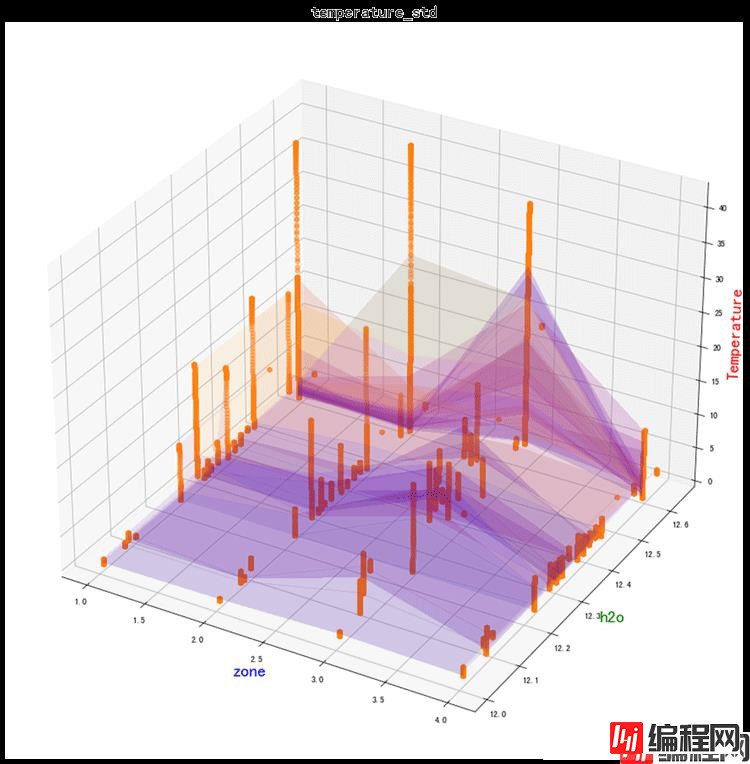Python 官方文档:入门教程 => 点击学习
目录1.散点图代码输入的数据格式2.三维表面 surface代码输入的数据格式scatter + surface图形展示3. 三维瀑布图waterfall代码输入的数据格式4. 3D
# This import reGISters the 3D projection, but is otherwise unused.
from mpl_toolkits.mplot3d import Axes3D # noqa: F401 unused import
import matplotlib.pyplot as plt
import numpy as np
# Fixing random state for reproducibility
np.random.seed(19680801)
def randrange(n, vmin, vmax):
'''
Helper function to make an array of random numbers having shape (n, )
with each number distributed UnifORM(vmin, vmax).
'''
return (vmax - vmin)*np.random.rand(n) + vmin
fig = plt.figure()
ax = fig.add_subplot(111, projection='3d')
n = 100
# For each set of style and range settings, plot n random points in the box
# defined by x in [23, 32], y in [0, 100], z in [zlow, zhigh].
for m, zlow, zhigh in [('o', -50, -25), ('^', -30, -5)]:
xs = randrange(n, 23, 32)
ys = randrange(n, 0, 100)
zs = randrange(n, zlow, zhigh)
ax.scatter(xs, ys, zs, marker=m)
ax.set_xlabel('X Label')
ax.set_ylabel('Y Label')
ax.set_zlabel('Z Label')
plt.show()输出:

这个输入的三个维度要求是三列长度一致的数据,可以理解为3个length相等的list。
用上面的scatter或者下面这段直接plot也可以。
fig = plt.figure()
ax = fig.GCa(projection='3d')
ax.plot(h, z, t, '.', alpha=0.5)
plt.show()输出:

x = [12.7, 12.8, 12.9]
y = [1, 2, 3, 4]
temp = pd.DataFrame([[7,7,9,9],[2,3,4,5],[1,6,8,7]]).T
X,Y = np.meshgrid(x,y) # 形成网格化的数据
temp = np.array(temp)
fig = plt.figure(figsize=(16, 16))
ax = fig.gca(projection='3d')
ax.plot_surface(Y,X,temp,rcount=1, cmap=cm.plasma, linewidth=1, antialiased=False,alpha=0.5) #cm.plasma
ax.set_xlabel('zone', color='b', fontsize=20)
ax.set_ylabel('h2o', color='g', fontsize=20)
ax.set_zlabel('Temperature', color='r', fontsize=20)output:

这里x和y原本都是一维list,通过np.meshgrid可以将其形成4X3的二维数据,如下图所示:


而第三维,得是4X3的2维的数据,才能进行画图

from matplotlib.collections import PolyCollection
import matplotlib.pyplot as plt
from matplotlib import colors as mcolors
import numpy as np
axes=plt.axes(projection="3d")
def colors(arg):
return mcolors.to_rgba(arg, alpha=0.6)
verts = []
z1 = [1, 2, 3, 4]
x1 = np.arange(0, 10, 0.4)
for z in z1:
y1 = np.random.rand(len(x1))
y1[0], y1[-1] = 0, 0
verts.append(list(zip(x1, y1)))
# print(verts)
poly = PolyCollection(verts, facecolors=[colors('r'), colors('g'), colors('b'),
colors('y')])
poly.set_alpha(0.7)
axes.add_collection3d(poly, zs=z1, zdir='y')
axes.set_xlabel('X')
axes.set_xlim3d(0, 10)
axes.set_ylabel('Y')
axes.set_ylim3d(-1, 4)
axes.set_zlabel('Z')
axes.set_zlim3d(0, 1)
axes.set_title("3D Waterfall plot")
plt.show()输出:

这个的输入我还没有完全搞懂,导致我自己暂时不能复现到其他数据,等以后懂了再回来补充。
from mpl_toolkits.mplot3d import axes3d
import matplotlib.pyplot as plt
fig, (ax1, ax2) = plt.subplots(
2, 1, figsize=(8, 12), subplot_kw={'projection': '3d'})
# Get the test data
X, Y, Z = axes3d.get_test_data(0.05)
# Give the first plot only wireframes of the type y = c
ax1.plot_wireframe(X, Y, Z, rstride=10, cstride=0)
ax1.set_title("Column (x) stride set to 0")
# Give the second plot only wireframes of the type x = c
ax2.plot_wireframe(X, Y, Z, rstride=0, cstride=10)
ax2.set_title("Row (y) stride set to 0")
plt.tight_layout()
plt.show()output:

与plot_surface的输入格式一样,X,Y原本为一维list,通过np.meshgrid形成网格化数据。Z为二维数据。其中注意调节rstride、cstride这两个值实现行列间隔的调整。
自己试了下:

到此这篇关于python 绘制3D图案例分享的文章就介绍到这了,更多相关Python 绘制3D图内容请搜索编程网以前的文章或继续浏览下面的相关文章希望大家以后多多支持编程网!
--结束END--
本文标题: python 绘制3D图案例分享
本文链接: https://lsjlt.com/news/119721.html(转载时请注明来源链接)
有问题或投稿请发送至: 邮箱/279061341@qq.com QQ/279061341
2024-03-01
2024-03-01
2024-03-01
2024-02-29
2024-02-29
2024-02-29
2024-02-29
2024-02-29
2024-02-29
2024-02-29
回答
回答
回答
回答
回答
回答
回答
回答
回答
回答
0